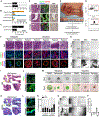Dysplastic Stem Cell Plasticity Functions as a Driving Force for Neoplastic Transformation of Precancerous Gastric Mucosa
- PMID: 35700772
- PMCID: PMC9509466
- DOI: 10.1053/j.gastro.2022.06.021
Dysplastic Stem Cell Plasticity Functions as a Driving Force for Neoplastic Transformation of Precancerous Gastric Mucosa
Abstract
Background & aims: Dysplasia carries a high risk of cancer development; however, the cellular mechanisms for dysplasia evolution to cancer are obscure. We have previously identified 2 putative dysplastic stem cell (DSC) populations, CD44v6neg/CD133+/CD166+ (double positive [DP]) and CD44v6+/CD133+/CD166+ (triple positive [TP]), which may contribute to cellular heterogeneity of gastric dysplasia. Here, we investigated functional roles and cell plasticity of noncancerous Trop2+/CD133+/CD166+ DSCs initially developed in the transition from precancerous metaplasia to dysplasia in the stomach.
Methods: Dysplastic organoids established from active Kras-induced mouse stomachs were used for transcriptome analysis, in vitro differentiation, and in vivo tumorigenicity assessments of DSCs. Cell heterogeneity and genetic alterations during clonal evolution of DSCs were examined by next-generation sequencing. Tissue microarrays were used to identify DSCs in human dysplasia. We additionally evaluated the effect of casein kinase 1 alpha (CK1α) regulation on the DSC activities using both mouse and human dysplastic organoids.
Results: We identified a high similarity of molecular profiles between DP- and TP-DSCs, but more dynamic activities of DP-DSCs in differentiation and survival for maintaining dysplastic cell lineages through Wnt ligand-independent CK1α/β-catenin signaling. Xenograft studies demonstrated that the DP-DSCs clonally evolve toward multiple types of gastric adenocarcinomas and promote cancer cell heterogeneity by acquiring additional genetic mutations and recruiting the tumor microenvironment. Last, growth and survival of both mouse and human dysplastic organoids were controlled by targeting CK1α.
Conclusions: These findings indicate that the DSCs are de novo gastric cancer-initiating cells responsible for neoplastic transformation and a promising target for intervention in early induction of gastric cancer.
Keywords: CK1α; Dysplasia; Dysplastic Stem Cells; Gastric Carcinogenesis; Kras; Pyrvinium.
Copyright © 2022 The Authors. Published by Elsevier Inc. All rights reserved.
Conflict of interest statement
Conflict of interest
The authors declare no competing interests.
Figures







References
-
- Smyth EC, Nilsson M, Grabsch HI, et al. Gastric cancer. The Lancet 2020;396:635–648. - PubMed
-
- Bray F, Ferlay J, Soerjomataram I, et al. Global cancer statistics 2018: GLOBOCAN estimates of incidence and mortality worldwide for 36 cancers in 185 countries. CA Cancer J Clin 2018;68:394–424. - PubMed
-
- Correa P A human model of gastric carcinogenesis. Cancer Res 1988;48:3554–60. - PubMed
-
- Tan P, Yeoh KG. Genetics and Molecular Pathogenesis of Gastric Adenocarcinoma. Gastroenterology 2015;149:1153–1162 e3. - PubMed
-
- de Vries AC, van Grieken NC, Looman CW, et al. Gastric cancer risk in patients with premalignant gastric lesions: a nationwide cohort study in the Netherlands. Gastroenterology 2008;134:945–52. - PubMed
Publication types
MeSH terms
Substances
Grants and funding
LinkOut - more resources
Full Text Sources
Medical
Molecular Biology Databases
Research Materials
Miscellaneous

